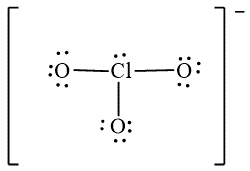
Concept explainers
(a)
Interpretation:
The electron-pair geometry for the molecules
Concept introduction:
The electron pairs in Lewis diagrams repel each other in real molecule and thus they distribute themselves in positions around the central atoms that are as far away from one another. This arrangement of electron pairs is called electron-pair geometry. The electron pairs may be shared in covalent bond, or they may be lone pairs.
Answer to Problem 21E
The Lewis diagrams for
![]() ,
,  and
and 
The wedge-and-dash diagrams for
![]() ,
,  and
and 
The electron pair geometry for
Explanation of Solution
To write the Lewis diagram for a compound first the number of valence electrons is to be calculated. In the molecule,
In the molecule,
Similarly, in the molecule
The atom which is least electronegative is the central atom. In
![]()
Figure 1
In

Figure 2
In

Figure 3
The electron-pair geometry depends on the number of electron pairs around the central atom. In the molecule
The wedge-and-dash diagram for the molecules
![]()
Figure 4
The wedge-and-dash diagram for the molecules

Figure 5
The wedge-and-dash diagram for the molecules

Figure 6
The Lewis and wedge-and-dash diagrams for
(b)
Interpretation:
The molecular geometry prdicted by the valence shell electron-pair repulsion theory for the molecules
Concept introduction:
Molecular geometry is the precise term that is used to describe the shape of molecules and arrangement of atoms around the central atom. The molecular geometry of a molecule is predicted by valence shell electron-pair repulsion theory or in short VSEPR theory. VSEPR theory applies to substances in which a second period element is bonded to two, three, four, or other atoms.
Answer to Problem 21E
The Lewis diagrams for
![]() ,
,  and
and 
The wedge-and-dash diagrams for
![]() ,
,  and
and 
The molecular geometry for
Explanation of Solution
To write the Lewis diagram for a compound first the number of valence electrons is to be calculated. In the molecule,
In the molecule,
Similarly, in the molecule,
The atom which is least electronegative is the central atom. In
![]()
Figure 1
In

Figure 2
In

Figure 3
The molecular geometry depends on the number of electron pairs around the central atom and the number of lone pair on the central atom. In the molecule
The wedge-and-dash diagram for the molecules
![]()
Figure 4
The wedge-and-dash diagram for the molecules

Figure 5
The wedge-and-dash diagram for the molecules

Figure 6
The Lewis and wedge-and-dash diagrams for
Want to see more full solutions like this?
Chapter 13 Solutions
Introductory Chemistry: An Active Learning Approach
- Germanium chloride, GeCl2, has only two atoms surrounding the central germanium atom. Why then is the germanium chloride molecule bent? Group of answer choices There is a covalent bond between the two chlorine atoms. Lone pairs of electrons on the chlorine atoms push it to this orientation. It is bent only periodically as it swings between both bent and linear shapes. A lone pair of electrons on germanium pushes it to this orientation.arrow_forwardDraw the shapes of the following molecules and ions in 3-dimension. Show clearly any lone pairs of electrons on the central atom, state the number of bond pairs and lone pairs of electrons on the central atom and name the shape of the molecule or ion. (a) PH4+, phosphonium ion (b) PBr5, phosphorus pentabromide (c) H3O+, oxonium ion Provide everything stated in the instructions for each compound.arrow_forwardClassify each of the following statements as true or false: a Molecular geometry around an atom may or may not be the same as electron-pair geometry around the atom. b Electron pair geometry is the direct effect of molecular geometry. c If the geometry of a molecule is linear, the molecule must have at least one double bond. d A molecule with a double bond cannot have trigonal pyramidal geometry around the double bonded atom. e A CO2 molecule is linear, but an SO2 molecule is bent. f A molecule is polar if it contains polar bonds. g A molecule with a central atom that has one lone pair of electrons is always polar. h A molecule with a central atom that has two lone pairs and two bonded pairs of electrons is always polar. i Carbon atoms normally form four bonds. j Hydrogen atoms never form double bonds.arrow_forward
- Indicate whether each of the following hypothetical triatomic molecules is polar or nonpolar. Assume that A, X, and Y have different electronegativities. a. a linear XAX molecule b. a linear XXA molecule c. an angular AXY molecule d. an angular XAY moleculearrow_forwardIndicate whether each of the following molecules is polar or nonpolar. The molecular geometry is given in parentheses. a. PH2Cl (trigonal pyramidal with P at the apex) b. SO3 (trigonal planar with S in the center position) c. CH2Cl2 (tetrahedral with C in the center position) d. CCl4 (tetrahedral with C in the center position)arrow_forwardWhich statements are true about electronegativity? (a) Electronegativity increases from left to right in a period of the Periodic Table. (b) Electronegativity increases from top to bottom in a column of the Periodic Table. (c) Hydrogen, the element with the lowest atomic number, has the smallest electronegativity. (d) The higher the atomic number of an element, the greater its electronegativity.arrow_forward
 Introductory Chemistry: An Active Learning Approa...ChemistryISBN:9781305079250Author:Mark S. Cracolice, Ed PetersPublisher:Cengage Learning
Introductory Chemistry: An Active Learning Approa...ChemistryISBN:9781305079250Author:Mark S. Cracolice, Ed PetersPublisher:Cengage Learning
 General, Organic, and Biological ChemistryChemistryISBN:9781285853918Author:H. Stephen StokerPublisher:Cengage Learning
General, Organic, and Biological ChemistryChemistryISBN:9781285853918Author:H. Stephen StokerPublisher:Cengage Learning

 Organic ChemistryChemistryISBN:9781305580350Author:William H. Brown, Brent L. Iverson, Eric Anslyn, Christopher S. FootePublisher:Cengage Learning
Organic ChemistryChemistryISBN:9781305580350Author:William H. Brown, Brent L. Iverson, Eric Anslyn, Christopher S. FootePublisher:Cengage Learning





